Immolation
Long a pillar of the New York scene, Immolation helped take brutal death metal to new dimensions of conceptualizing tone.
Dawn of Possession
Roadrunner
|
1991
|
|
|
Production: Solid and close.
Review: A unique fragment of the New York Death Metal sound was birthed with the first album from Immolation which wrought from complex and specific structures enwrapping rough chromatic death metal riffing an emphasis on the content of each song. Thunderous hollow vocals and exact percussion frame the rushing chaos of intricate riffs and extended thematic conclusions which synergize to form sensibility.
Tracklist:
1. Into Everlasting Fire
2. Despondent Souls
3. Dawn Of Possession
4. Those Left Behind
5. Internal Decadence
6. No Forgiveness (Without Bloodshed)
7. Burial Ground
8. After My Prayers
9. Fall In Disease
10. Immolation
Length: 42:44
|
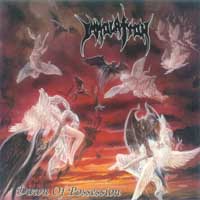
Copyright © 1991 Roadrunner
|
With a taste for the fast strumming of southern bands but an emphasis on the pounding rhythm of death metal worldwide, Immolation made from the sludgy metal of the northeast a style of riffing which brings out the tugging, dragging, tearing influence within otherwise fast riffing, allowing the band a flexibility of emotion within their ability to hammer out ripping vertiginous phrasing. Songs introduce concepts and return to them in accents through a cyclic exchange of motion in the various directions employed to route a cluster of riffs into familiar verses and choruses.
Unabashed in their desire for speed songs undulate within a theatre of growth and change, setting each scenario in listener consciousness with the symbolism of shaping and tone expressed in nihilistic but universally human riffing, and in this drama of the conflict within space is given to differing speeds including a raging blast. To the credit of the percussion department, beats incorporate more than one texture and use balanced internal emphasis to conserve momentum.
On their first album, Immolation can be seen making the transition from the straightforward death metal of their demo to a new and technical style within the advancements the death metal genre was to make in the early 1990s, seen most prominently on the newer songs on the first half of this release. Their strengths in perceiving existential consciousness and creating it in the shapes and vibrations of the communicating structure flower greatness throughout this album as groundwork for what is to come. In this motivation toward evolution as in all of its songs, this release shows a cognitive grasp of the spirit and strength of metal.
|
Here In After
Metal Blade
|
1996
|
|
|
Production: Streamlined metal.
Review: Renewing the assault with a powerful second album, Immolation emerge after five years to sculpt from pure sound a newly abstract form of their trademark guttural and uncertainty-inducing metal, using a panopoly of textures and chord voicings to augment rhythmic narratives through the mind of a blasphemer with decent reasons to hate Jesus.
Fitting concept, riffs are contorted and embrace odd and unnatural sounds in which an organic order can be discerned, congealing across songs through the repeated use of similar figures and tones to connect an internal outline of events. Blasphemic chaos in lead guitars deliberately unhinging tonal containers for the use of self-reflective and contorted sound eases transition between fertile bondings of verse and chorus and the evanescent, amorphous vocabulary of riffing which creates transition and tonal placement.
Tracklist:
1. Nailed to Gold (3:54)
2. Burn With Jesus (4:00)
3. Here In After (4:54)
4. I Feel Nothing (4:41)
5. Away From God (4:45)
6. Towards Earth (4:47)
7. Under The Supreme (4:23)
8. Christ's Cage (5:52)
Length: 37:22
|
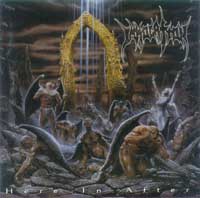
Copyright © 1996 Metal Blade
|
Introductory fragments meld into raging muffled chord playing which reverts to the pure streaming of smooth guitar textures created via tremelo playing at high speed, before fountaining into harmonic possibility and dissolving into chaotic and dissonant but expectant, fertile space for new motion. Depth of partially oppositional sounds enhances mood like descent into an uncharted cave. Transitory themes become reality in thunderous revelations, and unfurling riff progressions culminate in sensible yet abstractly inverted visions of theme. Over this the roar of solid connection in impact is rendered through vocals guttural yet pneumatically projective.
Songs attain reasonable complexity and where older Immolation would swerve through intricate exchanges of maze navigation, now stagger many memes throughout the piece. Where this release shows the completion of tactics unleashed on "Dawn of Possession," it leaves compositional space open for later releases through songs that while indulgent of structural variation are revealing their construction of composite parts in the compiled sense to its songs. The strength of this iteration of the music of Immolation is as always in the inventiveness of riff construction and imagination to match concept to content, rare attributes in any genre especially valued and needed in death metal at this time.
|
Stepping On Angels... Before Dawn
Repulse
|
1995
|
|
|
Production: Varying demo and garage.
Review: This collection of early works and pre-release versions of classics from the first album shows Immolation developing from old school death metal to a proto-technical level while simultaneously differentiating the band in concept and image. A glimpse into the mind of this developing musical force is like a cross-section of metal history as concepts develop from variants on known quantities to an evocative voice of will isolated in these individuals.
Tracklist:
1. Relentless Torment
2. Holocaust
3. Rigor Mortis
4. Warriors of Doom
5. Immolation
6. Dawn of Possession
7. Internal Decadence
8. Burial Ground
9. Despondent Souls
10. Infectious Blood
11. Despondent Souls ('90)
12. Burial Ground (live)
13. Infectious Blood (live)
14. Immolation (live)
15. Despondent Souls (live)
16. Dawn of Possession (live) & Morbid Visions (Sepultura cover)
Length: 71:51
|
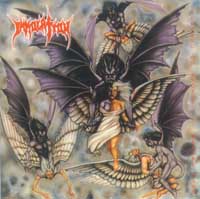
Copyright © 1995 Repulse
|
Known in their early days as Rigor Mortis (no relation to the Texas band), the band moved from punkish songs with pop construction in verse and chorus directness, sounding in many ways similar to Slaughter (Canada) or Master, toward a nihilistic and raw death metal sound applied with a level destructivity blanketing the listener in rapid and antagonistic perceptual tokens. These songs are easily listenable and with minimal pretense, deliver an unformed poetry of the shocked nerves of alienated youth.
This musical snapshot shows the primitive version of this rhythmic sense developing, as well as the beginnings of progressive intent in song structure, yet the music lacks the direction later to emerge and is in retrospect indistinguishable from many talented young death metal bands of the era. These can be inspected for clues to the minds of these creators, and many are there: early techniques of linking ideas resemble in the most organic abstract the pieces to come. For a clue to original inspirations, a live cover of "Morbid Visions" from Sepultura completes the recording.
The latter part of this release consists of live works of early Immolation and resembles unrefined versions of the second half of the first album. The live works demonstrate the tightness of this band and remain some of the most virulent recordings of these songs yet achieved. Propulsive and ambitious, this compilation will fulfill the blackest metalhead heart.
|
Failures For Gods
Metal Blade
|
1999
|
|
|
Production: Steely with dense tone albeit slightly thin.
Review: Like most complex things this music is an alternating series of influences from at least two simultaneous linear sources, moving its rhythms from the abrupt to the contiguous at the same time it migrates its harmony from the dissonant to a centering of the harmonic unevenness that permits slightly displaced, resonant melodies across varied structures (shape of melody denoted by modal similarities between interval stripes) in a style similar to the harmolodic work of Ornette Coleman or, centuries earlier, the fugues of J.S. Bach written in counterpoint yet harmonizing across the range of a pipe organ.
This is near a parallel melody technique yet crafted in a more organic sense of not parallelism but a central melodic narrative often employing negative space against and along with which submelodies emphasize depth of motivic metonymy within or referencing form of its shape, creating in their sequenced interaction a calculation of texture in tone of depth and balanced inconsistency to the harmonic symmetry it provides to central narrative and in derivation from that, unifying theme cluster including introductory material of the primal differentiation of harmonic spaces.
Tracklist:
1. Once Ordained (5:22)
2. No Jesus, No Beast (4:43)
3. Failures for Gods (6:25)
4. Unsaved (4:37)
5. God Made Filth (3:58)
6. Stench Of High Heaven (4:24)
7. Your Angel Died (5:26)
8. The Devil I Know (5:24)
Length: 40:21
|
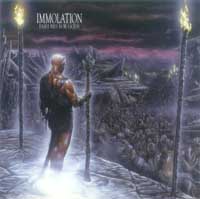
Copyright © 1999 Metal Blade
|
The rage has not left this band, which is evident by their extension of the ideas put forth in the stylistic changes on "Here In After" toward more than technique a voice and in vocalization, and their use of dissonance is sparser than either Voivod or their next most recent album, yet here there is a balance that exceeds the album prior through rhythmic and structural coherence which outshines their previous effort, on which the unison was unsteady and caused a lingering aftertaste of blocky assembly. Tight and narrow vocals hammer a cadence along the leading figure used by the drums and slot between beats a filling timbre while drums sprinkle and cacophonous fall into precise internal fills during the process of spreading unreality through suspended beats relying upon cadence and texture more than hesitation and delivery.
Invective against the church and Christ rings throughout this work with an overhashed repetition factor with a message many feel cannot be repeated enough; its main feature is the serpentine vocal bends and guttural snaps which anchor it to the changing topology of narrative. Songwriting uses arrangement like a weapon to work riffs into thematic directional points and exploit inherent tendencies of dissonance to create a rising wave of harmonic phenomena into which pure rhythm and melodic completion in abstract counterpoint to precept fall as means of working resolution, from which a proliferation of options and equally chaotic conclusion arise. Technicalists should not miss lead guitar, drum and bass performances from these musicians with professional attitudes.
This album remains enduring for its qualities of instrumental rigor and compositional integrity, with the latter meaning that each song on this flattened sphere rushes past the question of whether it is distinct from others with shape, concept and meaning unique to the particular articulation it wishes to express. Within a waveform of shifting textures and melodic anticipation set across a sequence of switches representing possible harmonies, songs expel what has never changed about art: its howling fusion of all emotions into an appreciation of life. In hellishness and the serenity of balanced and logical structure, "Failures for Gods" reigns at the top of a hierarchy of metal achievements.
|
Close to a World Below
Metal Blade
|
2000
|
|
|
Production: Clean and vibrant sound.
Review: As if rising from obscurity yet again Immolation create one of the finest death metal albums in recent memory in "Close to a World Below," which builds a theory of dissonance behind pounding and incendiary death metal. Similar to exploratory speed metallers Voivod this band of NYDM technicalists wrap the scale into a full range of usage and align tones in succession and parallel to form a deepening wave of paradoxical harmonizing disharmony. Played with a range of technique that is the envy of "brutal death" bands worldwide, this progressive yet deathy music is often undernoticed because of its natural, understated sound; from the bullet-precise drumming at escaped convict speed to the intricate cryptophalangonomicon of changing harmony and lead melody that guitars drill into the head of the listener.
As refined and developed as this album is, it has not "matured" in the way that bands like Metallica and Slayer have "matured" or "developed." Resembling an avantgarde jazz exercise in some ways through its diligent changing of textures and phrasing along intricate percussion lines and fractured, recombined song structures. Similar to Slayer in their older days, structure here serves the riff and can vary from relatively simple to deft and complex inductions of multiple themes into a stream of logarithmic insertions decoding the discursive attributes to each subtheme as expressed in riff. Resonant harmonization implying a vast space of sudden emptiness lingers at the end of each song.
Historically, NYDM sensu Morpheus Descends approximates what is here more than the Incantation/Havohej school of nihilistic modal stripe death metal, so the riff salad style made famous by that scene is created with a detailed finesse in a language that is more otherworldly than bash in your head heavy. Through this mechanism the music expresses the lyrical concept in that it develops a parity with the object of conflict, religion, through the basic force of inspiration in this music which is a theme of creativity out of destruction. Heroic mythos here demonstrates its equality to "God" on conversational terms, expressed in a mathematics of sound beyond the immediate level of perception. The result challenges listeners but delivers a bounty of learning on the other side of perception.
Vocals and bass deliver firm and unyielding support to symphonies of dissonance. Chording complements technical wandering and abstractly symmetrical leads in culmination of these long songs fit into a shorter space with a flash of power. Sonorous yet violent, the fourth Immolation album contributes another dimension of evolution to the reborn genre of underground death metal.
|
|
|
|
Production: Thin, with dramatic jumps in intensity and too much focus on vocals.
Review: Any scholar wishing to understand how metal is put together will benefit from study of this album, because it is simultaneously the best work Immolation has done and their nadir of stylistic, ideological and thematic integrity. As musicians, they have matured upward from the plateau found on their second album, and on this, the differences are subtle: a fine understanding of the emotions wrought from different types of melody, a detailed understanding of pace in the context of their traditional tugging and rebounding rhythm, a clear-sighted sequence of introduction of ideas.
Stylistically, they have descended: what separates "Harnessing Ruin" from other Immolation work is a tendency to make MTV-video-friendly songs that are chorus heavy and conclude evenly on a fade-out or other helpful device for terminating imagery; although their death metal technique remains immaculate when used, it is interrupted by bouncy nu-metal style drumming and horrid "obvious" songwriting devices, including alternation between whispering and screaming, distorted and acoustic guitars, thunderous bounce and smugly seamless fluid rhythms. Do we sense a presence of nu-metal, emocore and mainstream album-oriented rock? Yes, my precious. Will this kill the album for most metalheads, and put Immolation in dangerous territory as far as continuing as an underground metal band? True, true. Is the album still excellent? There's an argument to be made for it.
Tracklist:
1. Swarm Of Terror
2. Our Saviour Sleeps
3. Challenge The Storm
4. Harnessing Ruin
5. Dead To Me
6. Son Of Iniquity
7. My Own Enemy
8. Crown The Liar
9. At Mourning's Twilight
Length: 44:09
|
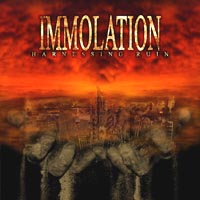
Copyright © 2005 Listenable
|
Some tracks sound hasty and could be eliminated, leaving an EP that especially if re-constructed in Immolation's trademark death metal technique would be mindblowing, but the songwriting -- the music, the flow of ideas, the use of musical language -- is excellent, even if style fails. In that there's an important lesson, but equally important is knowing that metal, like classical, is not a "jam" genre: one must find a clear concept for each album and each song and express it, more like sonic poetry and opera than musical noodling. Hard-driving anti-Christianity and the method of compositing complex riffs found on "Here in After" took Immolation only so far. This is a band in need of artistic direction, but at the top of their musical game. Most metalheads will probably find this album unsatisfying, but this reviewer is fond of it for despite its brutal failings, it provides a disjointed but imagically lucid view of the metal artform. This band needs a new aesthetic, one that hybridizes death metal with their Voivodian dissonant and inverted harmonies; they need a larger concept than simply "we detest Christ," perhaps even Unabomber-style taking on modern society as a creation of Christian ethics; they need a new goal, and whether it is mainstream or underground is irrelevant as long as the musical quality remains. Most tantalizingly, this album leads us to wonder what will happen when the next Immolation album, solidified with a clearer path, is created with the same balance of experience and freshness toward life that clarifies this work.
|
BLACK | DEATH | HEAVY | SPEED | THRASH | GRINDCORE
Copyright © 1988-2004 the Dark Legions Archive
|